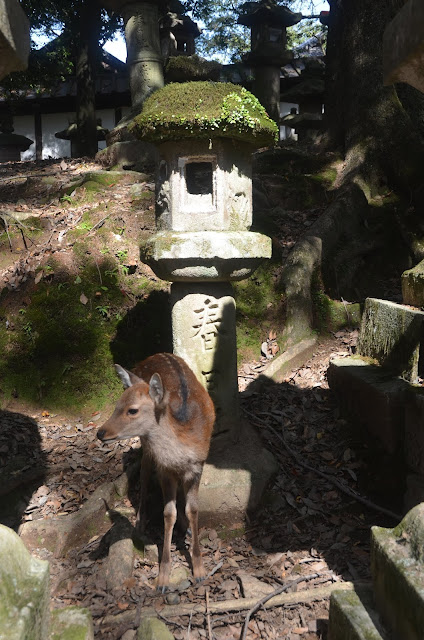Nara Park is most famous for the deer living in it. It was established in 1880 and currently is home to 100s of deer, which Nara is famous for. The deer are considered in Japanese religion to be messengers of the gods.
 |
| Nara Park |
 |
| Nara Park |
 |
| Nara Park |
 |
| Nara Park |
 |
| Nara Park |
 |
| Nara Park |
 |
| Nara Park |
 |
| Nara Park |
In the park they sell wafer like cookies for you to feed the deer for 150Yen/ pack. There are so many deer around the little booths selling cookies that they swarm tourists as soon as they buy some. This leads to entertaining views of tourists running and throwing cookies all over the place for the deer to get off the ground. If they think you will feed them they will chase you, headbutt you or bite you.
 |
| Nara park |
 |
| Nara Park |
 |
| Nara park deer fighting |
 |
| Nara park |
 |
| Nara park |
 |
| Nara park |
 |
| Nara park |
 |
| Nara park |
You can find the deer all over the park including some of the temple and shrine areas or even the shop areas.
 |
| Nara Park |
 |
| Nara park |
 |
| Nara Park |
 |
| Nara Park |
Kasuga-taisha (春日大社) is one of the oldest temples in Nara Par. The entrance is a deer fountain. The Shrine is composed of a few buildings and you can walk though them for a short distance.
 |
| Kasuga-taisha (春日大社) |
 |
| Kasuga-taisha (春日大社) |
 |
| Kasuga-taisha (春日大社) |
Other smaller shrines and tori gates are scattered throughout the park.
Tōdai-ji (東大寺) is the most famous temple in Nara. It is a large temple famous for the giant Buddha figure inside. The main giant Buddha is bordered by two other gold coloured statues on either side.
 |
| Nara Park |
 |
| Nara Park |
 |
| Tōdai-ji (東大寺) |
 |
| Tōdai-ji (東大寺) |
 |
| Tōdai-ji (東大寺) |
 |
| Tōdai-ji (東大寺) |
 |
| Tōdai-ji (東大寺) |
 |
| Tōdai-ji (東大寺) |
 |
| Tōdai-ji (東大寺) |
 |
| Tōdai-ji (東大寺) |
 |
| Tōdai-ji (東大寺) |
 |
| Tōdai-ji (東大寺) |
 |
| Tōdai-ji (東大寺) |
 |
| Tōdai-ji (東大寺) |
 |
| Model of previous main building of Tōdai-ji (東大寺) |
 |
| Model of current main building of Tōdai-ji (東大寺) |
 |
| Tōdai-ji (東大寺) |
 |
| Tōdai-ji (東大寺) |
Todaiji Hokkedo (Sangatsudo) (東大寺 法華堂(三月堂)) and Nigatsu-do (東大寺 二月堂) are two larger temples in Nara Park just above Tōdai-ji (東大寺).
 |
| Todaiji Hokkedo (Sangatsudo) (東大寺 法華堂(三月堂)) |
 |
| TNigatsu-do (東大寺 二月堂) |
 |
| Nigatsu-do (東大寺 二月堂) |
 |
| Kōfuku-ji (興福寺), Five-storied pagoda (五重塔 Gojū-no-tō) |
 |
| Kōfuku-ji (興福寺), South Octagonal Hall (南円堂 Nan'endō) |
 |
| Kōfuku-ji (興福寺), South Octagonal Hall (南円堂 Nan'endō) |
 |
| Kōfuku-ji (興福寺), Five-storied pagoda (五重塔 Gojū-no-tō) |
 |
| Kōfuku-ji (興福寺), Five-storied pagoda (五重塔 Gojū-no-tō) |
 |
| Kōfuku-ji (興福寺), Five-storied pagoda (五重塔 Gojū-no-tō) |
 |
| Kōfuku-ji (興福寺), Five-storied pagoda (五重塔 Gojū-no-tō) |
 |
| Yoshiki-en (吉城園) |
 |
| Yoshiki-en (吉城園) |
 |
| Yoshiki-en (吉城園) |
 |
| Yoshiki-en (吉城園) |
The trails are lush green and although there isn't flowers like in North American gardens the area is pretty and the scenery is well kept.
 |
| Yoshiki-en (吉城園) |
 |
| Yoshiki-en (吉城園) |


No comments:
Post a Comment